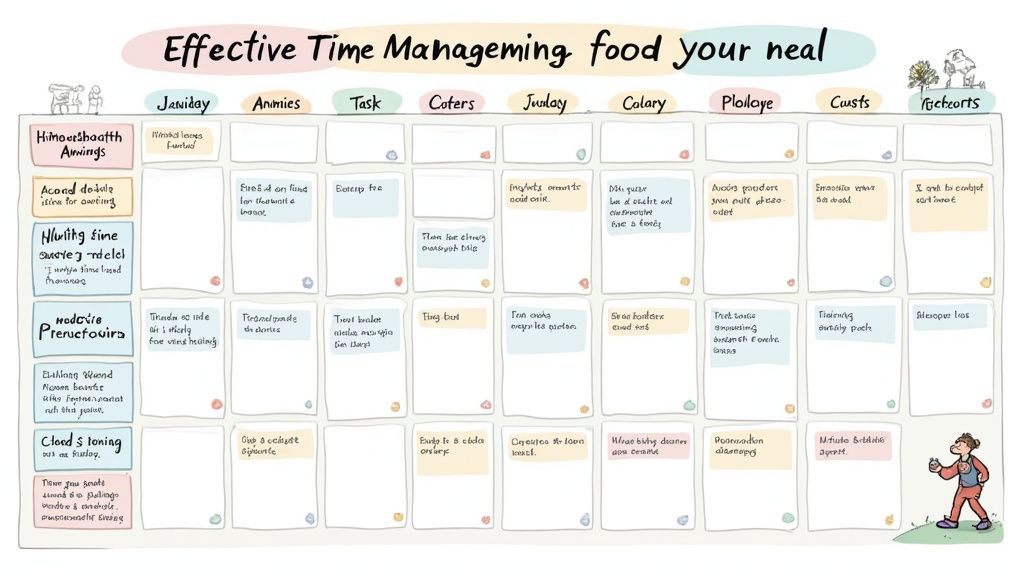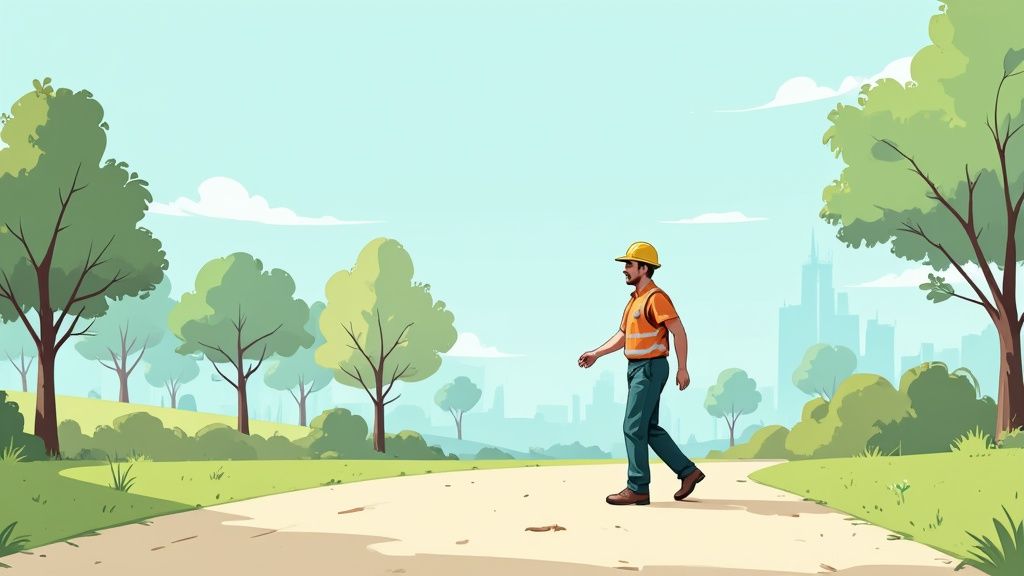How to Stay Focused at Work: Boost Your Productivity
Understanding Today's Focus Challenge

Focusing at work has become increasingly difficult. Between endless notifications, chatty open offices, and the pull of social media, maintaining concentration feels like swimming upstream. Many of us find that despite our best intentions, deep work remains elusive. This goes beyond simple willpower - the very nature of modern workplaces often undermines our ability to focus.
The Neuroscience of Distraction
Our brains weren't built for today's information overload. Each ping, email and conversation fragment forces a mental gear shift. Scientists call this context switching - and it comes at a real cognitive cost. Picture your mind like a computer running multiple programs - eventually, things slow down. Research shows that even brief distractions can derail focused work for several minutes. That quick peek at Instagram doesn't just cost a few seconds - it disrupts your mental flow long after you look away.
The Productivity Gap
Focus directly impacts how much we accomplish, yet the numbers paint a concerning picture. According to research from Time Doctor, 48% of employees report being productive less than 75% of their workday. Even more striking, 18% say they're productive less than half the time. This reveals a clear productivity gap between time spent at work versus actual focused output. The pressure to always be available only makes this worse, leading many to feel burned out.
Rethinking Traditional Productivity Advice
Standard productivity tips often miss the mark. While to-do lists and time blocking can help, they don't solve the core issue - our struggle to direct and sustain attention. A perfectly scheduled day won't make you immune to distraction. The next section explores practical ways to tackle the root causes of scattered focus and build lasting concentration skills at work.
Mastering Workplace Distraction Management

Staying focused at work requires more than just sheer willpower - it demands a smart approach to managing interruptions. Understanding what pulls your attention away and having specific solutions ready makes a big difference. Let's explore how to build a distraction-proof system that works.
Common Workplace Distractions and Solutions
Before diving into specific strategies, let's examine the most common workplace distractions and how to handle them effectively:
Digital Notifications
High
Set "Do Not Disturb" hours
Easy
Chatty Coworkers
Medium
Use headphones & clear signals
Medium
Email Overload
High
Scheduled check times
Medium
Workspace Clutter
Medium
Daily 5-min cleanup
Easy
Social Media
High
Website blockers
Easy
Noise Levels
Medium
Noise-canceling headphones
Easy
Identifying Your Distraction Profile
Start by tracking what pulls you off task most often. Do you constantly check your phone? Get caught in long conversations? Research shows workers typically spend only 12 minutes on a task before being interrupted, and it takes 25 minutes to get back into the flow. Check out more workplace distraction stats on Clockify's blog.
Practical Strategies for Minimizing Distractions
Once you know your main distraction triggers, put specific solutions in place. Set clear boundaries about when you're available to chat and when you need focused time. Your workspace setup matters too - keep it clean and organized to help your brain stay on track.
Try these proven techniques:
Time Blocks: Schedule focused work periods and treat them like important meetings
Two-Minute Tasks: Handle quick items immediately to prevent mental clutter
Task Batching: Group similar activities to avoid constant context switching
Creating a Sustainable Focus System
Finding what works best for you takes some trial and error. Some people thrive with complete silence, while others need background music. Tools like Obsibrain can help by keeping your tasks and notes in one place, reducing the need to switch between apps.
The key is building habits you can maintain long-term. Start small, adjust as needed, and celebrate your progress. With consistent practice, you'll get better at protecting your focus and getting more done with less stress.
Unlocking Deep Focus Through Engagement
Getting into flow state isn't just about blocking distractions - it's about finding work that pulls you in completely. When you're working on something that genuinely interests you, outside interruptions seem to fade away naturally. Let's look at how to build that level of engagement to improve your focus and get more done.
The Power of Purpose
Having a clear "why" behind your work makes focusing much easier. Seeing how your individual tasks connect to bigger goals gives you natural motivation to stay on track. Take coding a new feature - when you understand how it will make users' lives better, you'll likely find yourself more absorbed in the work and less tempted by distractions. This bigger picture perspective helps you stay locked in.
Cultivating Meaningful Connections
People focus better when they feel part of a team. Building real relationships with coworkers creates shared purpose and better collaboration. You're more likely to stay engaged when you can bounce ideas off teammates who "get it." Plus, positive social connections at work help reduce stress, which directly improves concentration.
Fostering a Focus-Friendly Mindset
Developing a growth mindset is key for maintaining engagement. This means viewing challenges as chances to learn and believing you can build new skills over time. With this outlook, you naturally approach work with curiosity rather than dread, making it easier to maintain focus even during tough tasks.
Recent data shows only 36% of employees feel truly engaged at work according to Gallup. However, engaged teams show 21% higher profitability. See the full research here. These numbers highlight why it's worth investing in an environment that encourages real participation.
Practical Tips for Boosting Engagement
Here are some concrete ways to increase your engagement and focus:
Connect Your Work to Your Values: Look for ways your daily tasks align with what matters most to you
Seek Opportunities for Growth: Take on projects that push you to learn new skills
Build Strong Relationships: Make time to connect with coworkers beyond just work tasks
Practice Mindfulness: Stay present and aware during your work instead of going on autopilot
By actively building engagement, you create the conditions for sustained focus and better results. This approach helps both your individual performance and contributes to a more energized work environment overall. Up next, we'll explore how to set up your physical workspace to minimize distractions and maximize concentration.
Creating Your Ideal Focus Environment

Your workspace shapes how well you can focus. Just as plants need good soil to grow, your work environment impacts your ability to concentrate and get things done. This includes both your physical setup and the digital tools you use each day.
Optimizing Your Physical Workspace
The space where you work directly affects your focus, whether at home or in an office. Start with a clean desk - removing clutter helps clear your mind. Pay attention to ergonomics too. A poorly set up workspace leads to physical discomfort that pulls your attention away from work.
Get a supportive chair and position your monitor at eye level. Good lighting is essential too. These small changes make a big difference - when you're comfortable, you can focus better on your work instead of shifting around in an uncomfortable chair.
Taming Digital Distractions
Your digital space needs as much attention as your physical one. Keep your computer organized by sorting files and closing extra browser tabs. Turn off notifications that aren't essential - they're one of the biggest focus-killers. With 49% of people now working in hybrid setups, managing focus is key whether you're at home or the office. Check out more workplace stats at Deel's workplace statistics.
Creating a Personalized Focus Zone
Everyone has different needs when it comes to focusing. Some people work best in complete quiet, while others like background noise. Try different setups to find what helps you concentrate best.
Key elements to consider:
Lighting: Use natural light when possible, or get a good desk lamp
Temperature: Keep your space slightly cool for better focus
Sound: Try noise-canceling headphones or background music
Scent: Simple scents like peppermint or lavender can help you stay alert
Integrating Obsibrain for Seamless Focus
Obsibrain helps create a focused digital workspace by keeping everything in one place. Having your tasks, notes, and goals all within Obsidian means less switching between apps and fewer distractions. This setup works well whether you're at home or in the office, helping you stay focused on what matters. As more people split time between home and office work, having a central hub for your work becomes even more important.
High-Impact Focus Tools and Techniques
Getting focused at work requires more than willpower - it needs the right mix of tools and methods that match your work style. Here's a practical guide to the most effective options and how to put them to work.
Digital Tools That Actually Help You Focus
The right digital tools can make a big difference in your focus levels. First, take a close look at which apps you're using now. Which ones actually help you work better, and which ones just waste time?
Let's compare some top productivity tools and their real impact on focus:
Task Managers
Single workspace, minimal switching
Deep work sessions
9/10
Site Blockers
Custom blacklists, scheduled blocking
Reducing distractions
8/10
Focus Timers
Timed work/break intervals
Building focus habits
7/10
Note-taking
Connected notes, quick capture
Project organization
8/10
Here are some specific tools worth trying:
**Obsibrain:** Combines tasks, notes, and goals in one place. Great for minimizing app switching and staying in flow.
Website Blockers: Stop distracting sites during work hours to build better habits.
Focus Timers: Use the Pomodoro method (25 min work + 5 min break) to train your focus muscle.
Proven Focus Methods That Work
Beyond apps and tools, certain time-tested techniques can seriously boost your ability to concentrate. Try matching your work schedule to when you naturally feel most energetic.
Do Hard Work Early: Take on challenging tasks when your mind is fresh, usually in the morning
Group Similar Tasks: Put related work together to avoid mental gear-shifting
Set Clear Boundaries: Let others know when you need quiet time - use headphones or "do not disturb" signals
Building Your Personal Focus System
There's no perfect focus system that works for everyone. The key is testing different approaches to find what clicks for you personally. Consider your specific work environment and job demands.
Try this simple process:
Map Your Distractions: What specifically breaks your focus most often?
Pick Targeted Solutions: Choose tools and methods that address your main focus challenges
Check Your Results: Keep track of how well you're able to focus over time
Keep Adjusting: Fine-tune your system based on what you learn works best
With a thoughtful, personalized approach to managing your focus, you can create a work environment that helps you concentrate deeply and get more done, while feeling less scattered and more accomplished.
Building Lasting Focus Habits

Great focus at work is like training for a marathon - it requires consistent practice and the right mindset. Building good concentration habits helps you stay productive even during busy times. Let's look at practical ways to develop better focus.
The Power of Habit Formation
Just like you brush your teeth without thinking about it, focus can become automatic too. When you make concentration techniques part of your routine, they require less mental effort. This lets you put more energy into your actual work instead of forcing yourself to stay on task.
Building Better Focus Skills
Your ability to focus gets stronger with regular practice, just like exercising builds muscle. Start with one small change, like checking your phone only during breaks. Once that becomes natural, add another positive habit. Small steps lead to big improvements.
Managing Stress to Stay Focused
When stress levels rise, concentration takes a hit. Your mind starts racing and it's hard to stay on task. Simple stress-busters like a 5-minute meditation or quick walk can help clear your head. These mini-breaks help you return to work with fresh focus.
Track Your Progress and Adjust
Building focus is an ongoing process that needs regular check-ins. Pay attention to what affects your concentration - do notifications distract you? Does your focus drop after lunch? Understanding your patterns helps you make smart changes. Like a runner tracking their miles, monitoring your focus helps you improve.
Practical Tips for Better Focus
Pick One Change: Start with a single focus habit and master it
Block Focus Time: Schedule specific periods for concentrated work
Take Smart Breaks: Brief pauses help prevent mental fatigue
Practice Mindfulness: Simple breathing exercises improve mental clarity
Monitor and Modify: Keep track of what works and adjust as needed
Obsibrain makes building focus habits easier. By keeping your tasks, notes and goals in one place within Obsidian, you'll have fewer distractions and a clearer workflow. Start developing stronger focus habits today with Obsibrain's integrated tools.
Last updated
Was this helpful?